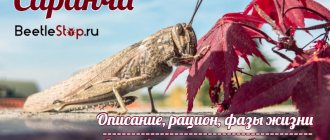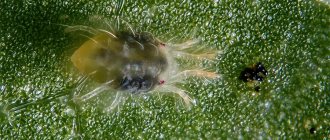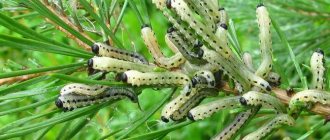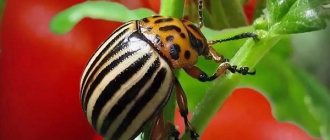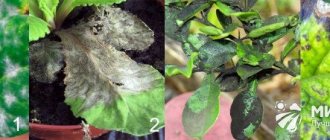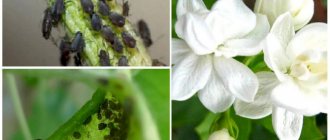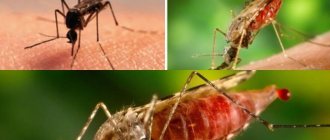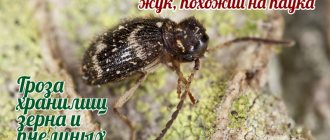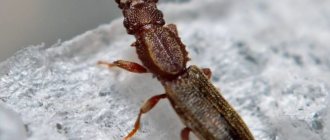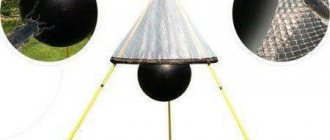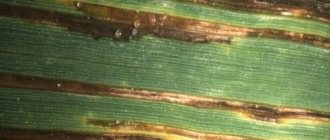Wheat, like other grain crops, is susceptible to various negative factors, which include not only frost or drought, but also the activity of insect pests. In order to prevent a decrease in the productivity of cereal crops and guarantee high yields, insecticidal treatments are regularly carried out on the fields. However, insect attacks on grains do not stop even after they are harvested. When the crop is harvested and sent for storage, field pests are replaced by barn pests, and the damage from their activity is in no way inferior to the damage caused by their field counterparts: - infected products lose weight; — the processes of self-heating of the grain mass are accelerated and intensified; — food and seed qualities are lost; — mold processes are activated (penicillosis, aspergillosis); — insects poison the products with toxic secretions, contaminate them with chitinous shells and larval cuticles. The greatest damage to stored crops is caused by beetles that colonize the grain mass and overwinter in the crevices and cracks of granaries. They undergo a complete transformation, that is, they become adult insects, having passed the pupal stage. This stage in the life of pests becomes the only one when they do not damage stored supplies.
A distinctive feature of adult insects is the presence of hard elytra covering the second pair of wings and abdomen necessary for flight. The larvae hatched from eggs have a fleshy body and a pronounced head part, on which the gnawing mouthparts are located. Unlike caterpillars, beetle larvae have legs that are poorly developed or are present only on the front part of the body.
There are several types of these pests, the most common in our country. Each of them has its own differences and behavioral characteristics:
Rice weevil
External structure: Small beetle 2-3.5 mm long. The body is brown-brown, matte. The beetle's head is elongated into a trunk-like rostrum, the antennae are curved forward. A characteristic feature is the presence of four reddish spots - two located at the base and another pair closer to the end of the elytra. The beetle's wings are developed and can fly.
The larvae are fleshy, 2.5-3 mm long, with a convex back and a brownish head, white, legless.
The pupae reach 2.75 mm, are shaped like an adult insect, and change color from white to yellow over time.
Lifestyle: The female gnaws a hole in the grain where she lays an egg. After 6-9 days, the larva appears and begins to eat the nutritious part of the grain. It first moves towards the center, and then along the groove, i.e. two larvae can develop in one grain at once if they end up on opposite sides. After 2-3 weeks, pupation occurs, which lasts 5-10 days. Then adult beetles emerge from the grains. In total, a female can lay from 300 to 570 such eggs in her life. Depending on conditions, from 2 to 4 generations of beetles can change in a year.
The favorable temperature for the life of the rice weevil is 27-30 oC. They spend the winter inside the grains, and in the absence of produce, they clog up in cracks, joints and other secluded places in structures. If the environment cools to 13 oC or lower, and grain moisture reaches 10% or less, the development of this pest is interrupted and the beetles begin to die.
Rice weevils are active and can travel long distances. Fields adjacent to an infected granary can be affected by them. They are capable of freezing if they feel threatened - any shake, and the beetle pretends to be dead.
Prevalence: Found in the southern regions of the Russian Federation. In the northern parts of the country, it can live only in warm rooms, where it enters along with brought grain shipments, where it successfully winters. It starts more often in places where there are problems with ventilation.
Damage: Adults spoil wheat throughout their lives, eating the outside of the soft parts of the grains. The greatest damage is caused by the larvae, which eat the grain secretly, from the inside. Due to its heat-loving nature, the beetle is able to penetrate deep into the embankment. Affected products lose from 35% to 75% of weight. The rice weevil is considered the most common pest. The damage caused to grain by other insects is always compared with the damage caused by them (the harmfulness coefficient is 1).
Where do weevils come from?
Quite often weevils appear in the apartment. Where they come from is of interest to many people, since bugs pose a great danger. The insect destroys all products it can reach. This pest quickly adapts to a new environment and tolerates various natural changes quite freely.
The person himself introduces weevils into the house along with food from the store or market. Cereal products become infected with them while still in the warehouse, and then end up on packaging and store shelves.
When purchasing products with weevil faces and eggs in a store, it is very difficult to notice them, since the grains remain clogged inside. And only when an adult emerges from them will it be possible to notice traces of damage and the bugs themselves.
Barn weevil
External structure: The body of this beetle is more cylindrical than that of the rice beetle. It is significantly larger than its counterpart - 3-4.5 mm in length. In front is a rostrum with curved antennae (they are also called grain elephants). In females it is curved and longer than in males. The shell is shiny. The elytra are fused (not capable of flight), and longitudinal grooves are clearly visible on them. The color of the insect changes with age from light brown to brown-black.
The larva is larger than that of rice - 3-4 mm.
The pupa is 2.7-5 mm long.
Lifestyle: Development is similar to rice. It is less fertile - the female lays 150-300 eggs. The behavior of the larva is different in that it immediately strives to occupy the center of the grain (one grain - one larva). The barn weevil lives longer; a maximum of 2-3 generations can be replaced in a year. It is more resistant to cold. The favorable air temperature for it is 25 oC. A decrease to 3 oC puts the beetles into torpor, and at 0 oC they die (in dry grain faster than in wet grain).
Prevalence: Found in all regions of Russia. In the southern parts of the country it is more active and reproduces faster.
Harm: Damages grains similar to rice. Less widespread, but more dangerous (harmfulness coefficient 1.5). It tolerates cold more easily, and therefore infects the surface layers of products (0.5 m deep).
Characteristic
The granary weevil is also called the grain weevil. This is an insect whose body does not exceed 5 mm. The size of the bug depends on the food it consumed during its development. The body shape resembles a slightly narrowed cylinder, the surface is shiny. The color of a broadmouth depends on its age. Thus, young individuals are colored light brown, while adults are almost black in color.
Barn weevil
The head of the weevil is very small, extended forward into a rostrum, at the end of which there is a mouthparts with which the grain weevil gnaws its food. The antennae located on the head are curved. The insect has wings: elytra with deep longitudinal grooves, membranous wings.
Interesting!
Despite the fact that the granary weevil is “equipped” with wings, it moves only with the help of its legs, since the development of the wings does not allow them to be used for these purposes.
Corn weevil
External structure: Similar to the rice weevil, but larger than its counterpart - from 2.5 to 5 mm in length. There is a slight gloss on the beetle's shell. The 4 reddish markings on the elytra are a brighter shade than the rice one.
Lifestyle: Similar to the rice weevil.
Distribution: Southern regions of Russia and central Chernozem region.
Damage: Similar to rice weevil. Its resistance to cold can compete with that of barn, and therefore its development is more difficult to contain by cooling the embankment.
Chemical methods of controlling weevils
One of the effective methods of getting rid of barn weevil is chemical disinfection of grain - a radical measure consisting of aerosol or gas treatment. Aerosol disinfection is carried out using the drugs “Aktellik”, “Karate”, “Fufanon”, “Arrivo”. This treatment, the advantage of which is the high effectiveness of the drug, is carried out by special organizations. The disadvantages of this method include the long period of time before permission to sell grain.
Gas disinfection is carried out with such drugs as Foskom, Alfos, Phostoxin, Magtoxin. The room must first be carefully sealed, and fumigation must be carried out with the involvement of specialized organizations.
Large flour beetle
External structure: A fairly large beetle, 13-17 mm in size, with clear antennae and long, dully shiny elytra, on which longitudinal stripes can be seen. Capable of flight. Young beetles are light brown in color, which becomes almost black over time. The legs and abdomen of the beetle are brown in color.
The eggs are white, oval in shape, 1.65-1.80 mm long.
The larvae are worm-shaped (they are also called mealworms), thick, from 25 to 35 mm long. In the first days it is distinguished by a white color, which over time turns into a yellowish-brown color. On the anterior segments of the body there are three pairs of short but well-developed legs; at the posterior end there is a pair of spines and two tubercles.
The beetle pupa is creamy yellow, 14-19 mm in size. There are two spikes at the rear end.
Lifestyle: The females of this beetle do not gnaw through grains, but lay eggs directly into the grain mass (usually in July-August). One individual can lay from 270 to 570 pieces. After 10-14 days, larvae appear and begin to damage the stored products. This stage of development lasts a very long time, and at low ambient temperatures it lasts up to 600 days. The larvae are extremely voracious, but can, if necessary, go without food for up to several months. They overwinter successfully at 0 oC, even with cold temperatures down to -5 oC they can survive for about 3 more months. To pupate, they get out of the grain mass and climb into cracks, behind partitions and into debris that accumulates in the room. After 6-47 days, an adult beetle emerges. Depending on the conditions, it takes from six months to 1.5 years to change the generation of these pests.
Prevalence: Found in both the southern and northern regions of Siberia and the European part of Russia.
Damage: Beetles and larvae eat the germ of the grain and feast on the mealy part. Damaged grains begin to rot and lose their seed quality. They enjoy eating flour and bran. Pests cause the greatest damage to wet and musty products. The larvae are very mobile, move easily in embankments and can penetrate to great depths. During their long lives, beetles produce huge amounts of toxic excrement that contaminates products. At the larval stage, the insect molts up to 30 times, and all shed shells remain in the mound. Adults often fly from contaminated products to new batches of grain at night.
Destruction of beetles in kitchen supplies
How to deal with such a dangerous pest as the barn weevil? How to get rid of such a small but harmful insect in the barn and kitchen? In terms of household supplies, if a weevil is found in cereals, you should not eat the latter, because the secretions of insects and larvae contain carcinogens. Infected products must be thrown away, and a tough and possibly lengthy fight must be waged against the weevil.
It is recommended to store cereals in jars or hermetically sealed containers - not in bags, which the granary weevil (photo above) can easily gnaw through with its sharp teeth. Barn weevils are heat-loving creatures and die at low temperatures. Therefore, as one of the ways to get rid of bugs, you can use cold: place products that serve as potential food for weevils in the freezer. High temperatures also have a devastating effect on the tiny resident. Thus, at +40°C the granary weevil dies within 2 days, at +50°C – after 6 hours. After processing, food supplies should be placed in sealed containers with tight lids that are impenetrable to insects.
Big dark hruschak
External structure: Similar to the large flour one, but slightly larger - 14-18 mm in length. The color of the shell is from dark brown to black, without shine. The longitudinal stripes of the elytra consist of densely located punctures. Adult beetles fly well.
Eggs size 1.4x0.7 mm.
The larva is up to 27 mm long, dense, dark coffee color. The last segment of the body is somewhat thickened, at the end there are a pair of small hooks and spines.
The pupa differs from that of the large flour pupa in color - it turns from initially white to yellow-brown.
Lifestyle: Gives one generation per year. Under unfavorable conditions, generation development can take up to 2 years. It is less common, but more prolific than its brother - the female lays from 460 to 970 eggs in her entire life.
Distribution: South of Western Siberia and southern regions of the European part of Russia.
Harm: Damages and clogs grain, like large flour. If the goods are packaged in bags, they chew through them. It flies from place to place and can contaminate clean batches of products.
Food storage rules
To store cereals and pasta, it is recommended to purchase containers made of food-grade plastic, glass or stainless steel with tight-fitting lids. It is not recommended to use paper bags, as weevils can easily gnaw through them. Before reusing the container, wash it with a solution of salt and soda. To do this, dilute 1 tsp. in 1 tbsp. water. Mustard and vinegar, taken in the same proportions, help.
Bulk foods should be stored in dry containers in a cool, dark place, preferably on the bottom shelf of a kitchen cabinet. To repel insects, place dried orange peel at the bottom of the container.
Source
Small mealworm
External structure: The beetle is similar to its larger counterparts, but is significantly smaller in size - 3-5 mm in length and about 1-1.26 mm in width. The chitinous shell has a red-brown tint and is slightly shiny. The prothorax is quadrangular in shape. Males have hairs on the rounded part of the abdomen. The beetle crawls fussily and cannot fly.
Eggs are white, 0.7 mm.
The larvae are from 3 to 7 mm in length. At the anterior end there are three pairs of legs; at the rear there are two hook-like triangular processes. The young larva is white, in later stages it becomes yellowish, and sparse hairs are visible on its body.
Pupae are no longer than 3.5 mm. In females you can notice two tubercles at the end of the abdomen, and in males there is a slight elevation.
Lifestyle: Adult beetles live up to 3 years. Females lay on average about 300-500 eggs over their lifetime, but individual individuals can lay up to 1000 eggs. Development occurs outside the grain. The eggs are covered with a sticky substance that collects dust and flour, thus providing camouflage. A week later, larvae emerge from them, which at 25 oC live in the mound for about 20 days. At low temperatures, the phase lasts up to 3 months. The subsequent pupal stage lasts another two weeks. Up to 4 generations of these pests can appear in a year, but with a high population density, beetles and larvae begin to eat eggs and pupae, independently reducing their numbers.
These insects are extremely sensitive to low temperatures, and at 0 oC they live no longer than 2-3 days. The pest prefers heated rooms and during the winter climbs into operating machinery and equipment in search of warmth. A decrease in air and product humidity does not affect their development.
Prevalence: Throughout the Russian Federation.
Harm: Is a pest of flour. It feeds on wheat grains only if they are damaged, as it is unable to gnaw through the grains. Contaminates food with excrement and cuticles. On the body of beetles there are odorous glands that impart an unpleasant odor to the product. Does not penetrate deeper than the upper layers of the embankment, but gets into remote and hard-to-reach parts of the equipment, which complicates cleaning.
How to destroy weevils using folk remedies?
At home, folk remedies are used to combat weevils. The most proven methods for ensuring the safety of products from the barn weevil:
- You should carefully inspect your inventory. If signs of the presence of weevils are found, the products should be thrown away, since the secretions of weevils and their larvae are dangerous to human health. This is the simplest and most proven method.
- Insects do not like strong odors. Place cloves of garlic, lavender or bay leaves in a container with flour products.
- The barn weevil does not tolerate high or low temperatures. Therefore, grain, flour, cereals, pasta can be kept in the oven at a temperature of 60°C and stored in the freezer. If food is kept at a temperature of -5°C for about a month, the beetles and their larvae will die.
- Products should be stored in glass or plastic containers with tightly closed lids that weevils cannot penetrate. If traces of weevils are found in one container, you need to check the others.
- Cabinets in which food is stored should be wiped with soapy water or vinegar solution.
You should not create large reserves of food that weevils and their larvae feed on.
Lesser black beetle
External structure: Similar to small flour, but slightly longer - 4.5-5.5 mm. The upper side of the shell is dark brown or black, the legs and abdomen are lighter.
The larvae differ from those of the small mealie in size - by the end of their development they reach 12 mm.
Lifestyle: Lays eggs on produce and in cracks and crevices of buildings. It differs from small flour flour in that it is more heat-loving and a little more demanding of moisture. Favorable temperature for development is 25-28 oC, product humidity is 15%.
Prevalence: Found throughout the Russian Federation, but more often in the southern regions.
Harm: Like the small mealy bug, it feeds on flour and the contents of damaged grains. Contaminated products acquire an unpleasant creosole odor.
How to deal with grain weevil: wise advice from experts
Due to the fact that people have to endure the annoying bug in their storage units, they have come up with various options to combat it.
Preventive measures have a special effect:
- cleaning the crop from all kinds of impurities and debris;
- warming up;
- cooling the grain before sending it to storage at a temperature;
- maximum drying of the product;
- thorough cleaning of the premises;
- disinfection of storage with special preparations.
If the barn is small, beetles are driven away with the help of fragrant plants. It could be lavender, garlic or regular bay leaf. Let's take a closer look at how to deal with grain weevils in order to preserve the crop until the next season.
Periodic movement of grain into storage has a detrimental effect on the development of pest larvae.
Cleanliness is a reliable protector against pests
Before putting grain into storage, it must be thoroughly cleaned of debris. A small amount of the crop is carefully inspected, removing weeds and large husks. A large volume of grain is cleaned mechanically. Thanks to this treatment, the chance to protect the product from beetle invasion increases.
An important control measure for granary weevil is humidity control and ventilation of the granary. It should always be dry and have enough fresh air. If necessary, the room is treated with chemicals.
The following options are available for sale:
Most often, hydrogen phosphide is used, which is sprayed throughout the storage area. For small spaces, the drug is used in liquid form.
If grain is stored in containers, they also need to be disinfected and cleared of debris.
"Ambulance" tablets
To protect the crop from annoying pests, scientists have created a special drug. Practice has shown that tablets against weevils in grain are an effective means of combating the pest. However, before using them, you must carefully read the instructions for use.
If grain is poured into a hopper, tablets are added as it moves quickly and quite sharply. To ensure protection of the product stored in bags, the drug is placed around them in small portions.
Suriname mucoed
External structure: The body of an adult beetle is elongated and flattened, from 2 to 3.5 mm long. The color of the shell is from yellow-brown to black-brown, the surface is matte. The head is extended forward. The last three segments on the antennae are club-shaped and thickened. The pronotum has 6 teeth on the sides, like a saw, and on the dorsal side you can see two longitudinal grooves. There is a constriction between the pronotum and the abdomen. The beetle's wings are well developed. The eggs are white, up to 0.9 mm, elongated.
The larvae are up to 4 mm long and also have a flattened shape. The color is white or white-yellow, the head part is brownish, with a pair of antennae. There are three pairs of legs in the front part.
Pupa 2.5-3 mm, yellowish. It is shaped like an adult insect, has 6 spines on the sides of the chest, one on each abdominal ring and 2 more on the end of the abdomen.
Lifestyle: The optimal temperature for the development of the pest is 25-27 oC; at 16 oC the species does not reproduce. In heated rooms they can produce up to 7 generations per year. At 0 oC the beetles remain viable for another 22 days, at -5 oC - 13 days.
These pests avoid light. Females lay eggs in small piles on moistened produce. One individual can lay from 100 to 300 eggs. The larvae appear after 10-12 days and, under favorable conditions, pupate within 18 days. Adult beetles emerge in 6-11 days and can live from six months to 3 years.
Prevalence: Throughout the Russian Federation. In the northern regions - only in heated rooms.
Damage: Beetles damage the outside of the grains, but the larvae can get inside the grains. Thanks to their flattened body, pests easily hide in cracks and containers, where they are difficult to notice. They damage packaging material and transmit bacteria and fungi. Having infected a batch of products, they are capable of multiplying in it in a short period of time. Insect excrement is toxic, eggs can cause gastrointestinal upset.
Red mukoed
External structure: Small beetle 1.5-2.5 mm long. The body is rusty-yellow, oblong, thicker than that of its Surinamese counterpart. A distinctive feature of these pests is their whiskers spread out to the sides, the length of which corresponds to the length of the insect’s body. The beetles are active and fly beautifully.
The larva is up to 4 mm long, cream-colored. The surface of the body is covered with hairs. The head is brown. At the reddish end of the abdomen, two hook-shaped outgrowths can be seen.
The pupa is 1.5-2 mm, cream or yellowish, covered with hairs and spines. At the end of the abdomen there are two spine-like projections.
Lifestyle: Females lay up to 100 eggs each. 3-5 generations of pests appear annually. The normal temperature for their development is 20-23 oC. When the temperature drops to 12-14 oC and the product humidity is below 15%, development does not occur. They can go without food for a long time, but low humidity leads to their rapid death.
Prevalence: Found throughout the Russian Federation in the southern regions and in the middle zone.
Harm: They feed on rotting grains or products with high humidity. They accumulate in large colonies in certain areas, where they contribute to self-warming and the development of mold processes. They clog the products with excrement and cuticles. They chew through packaging materials and sieves. They get into the cracks of buildings and spread through containers.
Extermination of fruit pests
Killing insects in summer cottages and gardens is no less difficult than killing weevils in stored grain. Treatment is planned in late spring, during flowering periods. They pay attention not only to trees, but also to currant bushes, gooseberries, strawberries, berries, and grapes. Timely spraying with special preparations has a positive effect. The procedure is repeated 2-3 times to completely remove the pest.
https://youtu.be/L6HgDPwvKeo
sadimsami.ru
Short-whiskered mukoeater
External structure: The smallest of the mucoeds is 1.5-2.4 mm long. It differs from the red one in that its mustache is half as long.
The larva is white and yellow, with three pairs of legs. The head part is brownish-brown. At the posterior end there are two spine-like projections.
Lifestyle: Can produce 3-4 generations in a year. Adult beetles fly actively in warm weather. They feel great at a humidity of 50%. They are extremely thermophilic - the optimal air temperature for them is 32-35 oC. At 18.5 oC, development is inhibited. However, these beetles are cold-resistant. A temperature of 0 oC allows them to live up to 100 more days, and even at -10 oC they die in only 20 days.
Distribution: Distributed everywhere. It is as common as the rice weevil.
Harm: Similar to the red mukoeater. In search of heat, they climb far into mechanisms and cracks, from where they are almost impossible to remove mechanically.
A small and distant bug
The insect got its name due to the unusual shape of its head. Its front part resembles an elongated proboscis. With its help, the bug destroys the dense skin of grain or cereal.
In the natural environment, there are many species of weevils that destroy:
- grain crops;
- peas;
- buckwheat;
- rice;
- corn.
Therefore, the question of how to combat the grain weevil is being decided at the state level. Otherwise, the country may lose the harvest and famine will occur.
The beetle belongs to the Coleoptera family. Its maximum size is approximately 4 mm. The weevil is dark brown in color. Doesn't fly. The active life cycle of an adult lasts approximately 2 years. The female produces 3 or 4 generations per year. She lays eggs inside the grain, where they go through all stages of development.
In order for the individuals to come out, the adult beetles gnaw a hole in the grain.
She can lay approximately 300 eggs per season, which can damage a large amount of grain. Mass reproduction of pests leads to an increase in the temperature of the stored crop. The pest overwinters inside the grain or in various crevices of the room.
Grain grinder
External structure: Beetle 2.5-3 mm long, cylindrical body, carapace color brown with a brown-cherry tint. The beetle's head is completely covered by the pronotum, like a hood, which distinguishes it from other pests. Short antennae with a three-segmented club at the ends. The insect's wings are developed.
The eggs are white, pear-shaped.
The larva is white, with a small brownish head. The anterior segments are thickened, with three pairs of legs. The back end is crocheted. Covered with very short hairs.
Lifestyle: Female beetles lay from 160 to 580 eggs, placing them one at a time or in small groups. The hatched larvae bite into the grains, where they feed, molt, and then pupate. Adult beetles emerge from the affected grains.
The most comfortable temperature for the pest is 25-30 oC, air humidity is 50%, grain humidity is 8-15%. Adult insects live up to a year. In the south of the Russian Federation they produce up to 6-8 generations. They tolerate high temperatures well, they are difficult to destroy by heating, but when the products are cooled they die relatively quickly (in 17 days at 0 oC and in 10 at -5 oC).
Prevalence: South and central zone of the Russian Federation.
Harm: The most dangerous of the barn beetles (harm factor 1.7). While developing in the grain, the larva consumes up to 30% of the nutrients. The adult destroys as much product as it weighs. The grains turn into a thin shell, eaten away from the inside. During their life processes, beetles and larvae secrete a huge amount of toxic excrement (muchel), as a result of which the products acquire a characteristic honey-mouldy smell. It flies actively during the day and can infect new batches of grain.
Conclusion
Thus, the strategy for protecting grain stocks from pests is based on a constant study of the characteristics of their distribution, development, reproduction and harmfulness, together with recommendations for comprehensive protection of grain at all stages, from procurement, transportation and ending with a long period of storage both inside storage facilities and beyond them.
L. Bondareva, Ph.D. agricultural Sciences, National University of Bioresources and Nature Management of Ukraine
Information for citation Threat to protected grain / L. Bondareva // Special railway station. Proposition. Grain: from the field to the elevator / - 2016. - P. - 28-32
Pretend Thief
External structure: A small beetle, reminiscent of a spider due to its retracted head and long legs, but with long antennae reaching to the middle of the body. Males are 2.8-4.3 mm long, brownish-red in color. Capable of flying. Females are 2.5-3.1 mm long, brown-black in color, with a more spherical abdomen. On the pronotum of the beetle there is a longitudinal groove and fluffy ridges on the sides; on each of the elytra there is a pair of light transverse bands.
Eggs are white, matte, 0.5-0.7 mm.
The larva has a curved back, white, with a yellowish and almost round head. Covered with short hairs. Can reach 5.5 mm in length. There are three pairs of legs at the anterior end.
The pupa is 3.5-4.9 mm, whitish, with a constriction at the base of the pronotum and a pair of pointed outgrowths at the posterior end of the abdomen.
Lifestyle: Pests are active at night. These beetles are called pretenders for their ability to fall into stupor at the slightest danger. The optimal temperature is 20-25 oC. If conditions are unfavorable, they can remain in a state of diapause for up to 280 days. Both adults and larvae with pupae can overwinter. Resistant to cold and increased temperatures. Larvae live at -5 oC for another six months, and at -10 oC up to 36 days. To destroy the eggs of pretenders, you will have to keep the contaminated products at 50 oC for about 15-16 minutes.
In heated rooms they give up to 3 generations per year. Females lay from 60 to 170 eggs for production. The emerging larvae, after three molts, make cocoons from the remains of the material they fed on. Pupation occurs not only in the grain mound, but also in other parts of the room: window frames, under baseboards, etc.
Prevalence: Found in warehouses in Siberia and the European part of the Russian Federation.
Harm: Under favorable conditions, they can quickly multiply in products and cause great damage. They feed on everything from grains to leather and wool, and will not go without food when the granary is empty. They clog the products with cuticles and excrement that look like flour or powder.
Ways to get rid of weevils
The weevil can enter an apartment along with a package of flour or grain, which was stored in warehouses for a long time and then went on sale. If at least one beetle is accidentally discovered in the kitchen, there is already a whole colony of them somewhere and you need to urgently decide how to get rid of the pests. You need to start fighting the beetle immediately, before it destroys all supplies.
The granary weevil is one of the most dangerous pests of grain stocks
The fight against weevils is carried out according to a simple scheme of actions:
- It is necessary to check all stocks of bulk products - cereals, pasta, flour, tea, coffee, cocoa, spices, etc. Products that have been heavily infested should be thrown away without regret, since the secretions of these beetles and their larvae can cause serious harm to human health .
- Grains and products in which the weevil was not found, and all recently purchased ones, should be placed in the freezer for several days. Cold effectively helps fight weevils. These insects are heat-loving; at +5°C they fall into torpor, and at -5°C the beetles and larvae die within a few days.
- Another means of combating weevils is heat. This beetle can withstand temperatures of +40°C for no more than two days, and at higher temperatures it dies in a few hours. Products that require preventive heating are placed in the oven and kept there at a temperature of 50-60°C for 6 hours. This will get rid of the beetles and their larvae.
- After treatment with cold or heat, the products must be poured into hermetically sealed glass or plastic containers into which the pest cannot penetrate.
- Garlic is often used as a folk remedy to repel weevils. A few cloves are placed in each container of cereals or pasta. It is important that the garlic cloves are well peeled, but the pulp is not damaged - damaged cloves quickly give off their smell to the grain and rot themselves. The same thing happens if you cut the garlic cloves into slices. An intact clove retains its repellent odor for a long time and does not rot.
- For preventive purposes, all furniture where food is stored is thoroughly cleaned from time to time using a soap solution, and then washed off with water to which a little vinegar is added. After cleaning, the furniture is dried and ventilated.
- To repel insects, strong-smelling lavender flowers and bay leaves are placed in cabinets and on shelves.
Detection of pests and control of them will be easier if you follow the rule - avoid creating abundant stocks, which will be stored for a long time without movement, becoming a comfortable habitat for beetles. It is easier to remove beetles when stocks are compact.
The question of how to deal with weevils in grain is faced by everyone who grows and stores cereals. This insect was known back in ancient Egypt.
Hairy pretender
External structure: Beetles from 2.3 to 3.5 mm long, dark brown or black in color. Females have a rounder abdomen. The elytra are covered with alternating rows of two types of hairs: the short ones are adjacent to the body, and the longer ones stick out. On the pronotum closer to the abdomen there are 4 cone-shaped tufts of hairs.
Eggs are 0.6 mm, fusiform, pearlescent in color.
The larvae are cream-colored, the head is brown, and grow up to 4 mm.
Lifestyle: Similar to the pretend thief. In April-May, after mating, females lay eggs in darkened parts of the premises (up to 40 eggs in total). However, adult beetles appear throughout the summer, since insects that overwintered in the larval stage complete development later.
Prevalence: Similar to the Fake Thief, but more common.
Harm: Damages the grain and clogs it with cuticles and waste products.
Advantages and disadvantages
The weevil is a creature extremely adapted to changing environmental conditions.
It feels comfortable in a temperature range of 16 to 28 degrees, but can tolerate more extreme temperatures. It is also not demanding of environmental humidity, since it spends most of its life inside the grain under the protection of its dense shell - exine. However, too dry air is destructive for most insects, including the weevil.
The duration of the beetle's life cycle depends on external conditions: the milder they are, the faster the insect reaches sexual maturity. If the temperature regime does not suit it, then the pest is able to fall into suspended animation and then return to a full life. Thus, the pest is capable of producing 2–3 generations during the year. Both beetles and larvae overwinter inside the grains. Also, adult insects feel good in crevices, cracks and other secluded places.
Read also: How to smoke lard: ways to smoke it correctly, recipes for smoked lard, benefits and harms
Together with damaged grain, as well as equipment, weevils migrate from one storage facility to another, damaging agricultural products.
Since man is forced to tolerate the presence of the weevil in his barns, he has developed a strategy to combat this pest. For prevention, the following means of control are used:
- cooling or, conversely, warming up grain and its processed products before storage;
- drying it out, because insects are critical to environmental humidity;
- cleaning grain from debris and impurities;
- cleaning of storage facilities and treatment by disinfestation. For this purpose, preparations based on hydrogen phosphorous (phosphine) are used, which are sprayed or used in the form of an aqueous solution;
- the use of ionizing radiation is at the development stage and may be used in the future.
The weevil grows not only in barns, but also in our homes. To prevent the beetle from spoiling our supplies, there are proven and harmless methods:
- place the cereal in the freezer for a while, and then pour it into sealed containers;
- since the insect does not tolerate strong odors, you can add peeled garlic cloves, bay leaves or lavender sprigs to the cereal;
- The cabinets where you store supplies must be washed with soap, soda or vinegar solution and ventilated well.
And finally, you shouldn’t stock up on cereals and pasta for half your life: fighting the harmful bug can become too long and exhausting at home.
Dried fruit glitter
External structure: A beetle with a wide, oval-shaped body, a small head and club-shaped antennae. The carapace is shiny, dark brown, with yellow spots on the elytra (the result is a wavy pattern on the back). The elytra themselves are short and do not cover the last segments of the abdomen. Females are 3.6-3.8 mm long, males - 3.2-3.5 mm.
The eggs are translucent, oval, 0.9x0.3 mm.
The larva grows up to 7.5 mm. Yellowish in color, with three pairs of legs in the front of the body.
Lifestyle: Females lay eggs, boring into the grain; after 2-4 days, larvae appear, which continue to gnaw the grain, digging real tunnels in them, where they later pupate. The larval and pupal stages last 8-10 days; one generation of beetles can develop completely in 20 days. Adults live for about a month. In just a year, at least 4 generations of these pests change.
Prevalence: Mainly in the southern regions of the Russian Federation.
Harm: Attacks grain with high humidity; in case of serious damage, a powdery mass remains from the product.
Moorish booger
External structure: Adult 6.5-11 mm long. The body is elongated and flattened. The carapace is shiny, light in young beetles, but over time it becomes brownish-black. The abdomen and legs are yellowish-rusty. A characteristic feature is a clearly visible constriction between the pronotum and the ventral part. Powerful mandibles are noticeable on the head, and antennae with club-shaped thickenings at the ends are located on the sides.
The eggs are matte white, cigar-shaped or spindle-shaped, 1.5x0.3 mm.
The larva is flattened, white-gray in color. Grows up to 20x3.5 mm. There are brown-black spots on the thoracic segments, the head and the rear end of the body with two growths of the same color. Has three pairs of yellowish legs.
The pupa is 7-11 mm, reddish, with a wide projection at the posterior end.
Lifestyle: Adults live up to 2 years, attack other insects. The larvae can attack each other. The beetles lay 10-60 eggs in the grain mass. The final fertility of a female ranges from 400 to 1300 eggs. After 10-12 days, larvae appear, which prefer dark places and begin to feed already at 10-11 oC.
The temperature suitable for the insect is 27 oC. In heated rooms, two generations of pests develop per year. In conditions unsuitable for development, the larvae enter diapause for 2-4 years. The insect overwinters in the imago and larval stages, gnawing a small passage in the wooden parts of warehouses and granaries, where it makes a cradle for itself.
Prevalence: Found throughout the Russian Federation, but less common in the north and east of the country.
Harm: They feast on the germ of hard wheat grains and the nutritional part in soft ones, depriving the product of food and seed value. They spoil packaging and damage building structures. They easily survive wintering in empty warehouses and can infect newly imported products.
Ham carpet beetle
External structure: The length of the beetle is 7-9 mm. Black color. The front part of the elytra is rusty-brown in color, with three black dots on each half. The border with the black part of the elytra is represented by a jagged line. The wings are developed, the beetles fly well.
The larva is spindle-shaped, with tufts of hairs of different lengths scattered throughout the body. The back is brown-black, the belly is yellowish. It has three pairs of legs and moves quickly.
Pupa 8-9 mm, yellow-brown. If the humidity of the product is low, then the last larval cuticle remains on top of the pupa.
Lifestyle: Optimum air temperature 18-20 oC. After fertilization, females lay 5-6 eggs daily for two months (100-170 in total). In summer, pests actively develop and feed; they overwinter in the adult stage. Beetles live up to a year, and within the same period a generation of pests is replaced.
Prevalence: Throughout the Russian Federation.
Harm: They feast on the germ of the grain, but can also gnaw on its outer part. They prefer products with high humidity.
Trogoderma variable
External structure: Adult black-brown, 2-4.6 mm. Elytra with three transverse stripes, less often with only one in the form of a loop. The pronotum and elytra are covered with brown and orange hairs. Antennae with club-shaped thickening.
The larva is cigar-shaped, with a tuft of red hair at the posterior end.
Lifestyle: Optimal development temperature is 30 oC. Females lay from 90 to 150 eggs. A new generation develops in 30 days, but there are only 1-2 generations per year. The larvae can go into diapause and go without food for up to 3 years.
Distribution: South and middle zone of Siberia and the European part of the Russian Federation.
Harm: Adults do not damage grain. The products are spoiled by larvae, eating away the nutritious parts of the grains. Such a pest can multiply only if the product is stored in a warehouse for a long time. It infects grain shipments, scattering throughout the territory of enterprises.
Completely common barn pests can become a real disaster for owners of stored grain. Their numbers and the threat they pose vary depending on the time of year and ambient temperature. The longer the grain sits in a warehouse, the more various insects and toxic substances remaining after their activities are in it. Losses can be avoided only by observing all phytosanitary requirements when accepting grain. To carry out quarantine phytosanitary disinfection, contact the First Fumigation Company. Our employees will always help you eliminate pests and save your money.
List of the most dangerous barn pests
Pests of grain and grain products (so-called granary pests
) are various types of mites and insects that partially damage or completely destroy grain and products made from it. Granaries that are infested with pests of grain and grain products are usually clogged with their excrement and even corpses. And heavily contaminated grain is not suitable for food either for people or animals.
Insect pests pose a huge threat to the agriculture of the Irkutsk region, as well as preventing the export of grain and products abroad. The losses caused by granary pests to grain stocks amount to millions of tons of grain. Grains affected by granary weevil and grain moth caterpillars lose up to half their weight; Wheat grains damaged by mucoeaters and various mites lose their viability. Barn pests, affecting products, heavily pollute them with the remains of their vital activity, and as a result, baked bread can be poisonous and also cause stomach diseases in people and animals.
Brown bread mite.
One of the largest pests of flour, grain and grain products. Products with high humidity are mainly affected; in case of mass reproduction, it causes enormous losses to agriculture. In the grain, the mite eats away the germ, after which the product acquires an unpleasant specific smell and taste, the flour is unsuitable for baking, and if it is severely damaged, the products cannot be used as food for people and animals.
Flour mite.
Pest of cereal grains, oilseeds, legumes; prefers flour, cereals, animal feed, etc.
Flour mite penetrates the embryo, thereby forming an infection in a latent form. The greatest danger is for the seed grain, since due to damage, a significant loss of germination occurs.
Barn weevil
. Damages the seed of wheat, barley, rye; reproduces with less intensity in grains of corn, oats, rice, buckwheat, and millet; also damages pasta and caked flour.
The female granary weevil gnaws a shallow hole in the grains and leaves one egg there (the fertility of one individual is up to 250 eggs). Over the course of several days, a larva will develop in the grain, where it will eventually turn into a pupa. When a young beetle emerges from the pupa, it initially remains inside the grain until the chitinous shell gets stronger and takes on its characteristic color. Then the beetle gnaws through the shell and comes out.
Mace beetle
. One of the most common and dangerous pests of grain and grain products.
These beetles are widespread, living in granaries with various types of grain, cereals, flour, feed, and also attack crackers, dried fruits, nuts and other products. A characteristic feature of the club beetle is that it has odorous glands that secrete a substance with a specific odor.
Khrushchak beetles have become so adapted to the relative humidity of the air that they actively feed and reproduce at one percent moisture content.
grain moth
. Female grain moths lay eggs in small clusters in spikelets in the field or directly into grains in warehouses. The larvae developing inside the grains feed on its internal contents. In granaries, the emerging caterpillars damage the surface layer of the grain, going deeper by 5-10 cm, with massive damage up to 20 cm. Inside the grains, the process of pupation and transformation into a butterfly occurs.
Mill moth
. Pest of grain of various crops and grain processing products, as well as nuts, dried fruits, and confectionery products. The mill moth lives in storage facilities and factories for processing grain and cereals; food warehouses and bakeries. The female mill moth lays eggs in food products and places them in crevices of storage areas and packaging bags. The main pest is the caterpillars of the mill moth, which damage the grains, entwining them with a dense web, knocking the products into large lumps.
Control measures.
During storage and storage, special attention should be paid to the moisture content of the grain. In no case should humidity exceed the standards established separately for seeds and food and feed grains. In case of long-term storage, it is better to reduce the humidity by 2-4% compared to the norm - this significantly increases the resistance of the grain to damage by pests and limits their vital activity. One of the effective measures to combat barn pests is grain cooling. It can be used both prophylactically and to suppress the vital activity of most pests. To do this, it is enough to bring the temperature of the grain mass to 8 ... 10 ° C. At a temperature of 5 ... 6 ° C, the shelf life increases threefold. Cooling is carried out in cold, dry weather using ventilation or active ventilation. During the cooling process, the equilibrium moisture content of the grain must be monitored: if it is lower than its actual moisture content, cooling can be performed, otherwise the grain, due to sorption, will become moistened. Cooling using refrigeration machines is more effective and reliable, but it requires additional means and special devices. Therefore, this measure is primarily recommended for crops that are especially unstable during storage, are quickly damaged by pests, and are affected by diseases: corn, grains and oilseeds. As a last resort measure to combat pests of grain stocks, their thermal disinfection is used at the maximum permissible temperatures. To select temperature conditions and duration of disinfection, you should use a special table that takes into account the type of pest and its thermal resistance. It is not recommended to disinfect seed grain in this way, since its similarity may be reduced. Disinfection of grain Chemical disinsection of grain continues to be a radical destructive measure to combat pests of grain stocks: aerosol, gas (fumigation). Chemical treatment is carried out according to special instructions and carried out by organizations that have official permission. Fumigation is especially strictly controlled: it is prohibited to use it for grain shipments intended for shipment and concentration at port elevators. Aerosol disinfection against barn pests is effective for treating vacant warehouses and surrounding areas. The advantage of aerosol treatment is the high effect of the drug even in unsealed storage facilities; its disadvantage is a rather long period of time before the permitted sale of grain. It is reliably known that after several months, drug residues do not exceed the maximum permitted level (MLL) and reliable grain protection is achieved when drugs are used in recommended doses. Gas disinfection (fumigation). Of the chemical measures, gas fumigation is the most effective. Before carrying out fumigation, it is necessary to carefully seal the room, and fumigation should be carried out with the involvement of only special teams with permission and appropriate equipment. Decontamination is a relatively short period - up to 10 days from the start of treatment. The fumigation regime is also associated with constant monitoring of the concentration and residue of the drug. The feasibility of fumigation should be determined based on the degree of pest damage and the economic efficiency of the planned work. Based on the total density of infestation by insects and mites, grain batches are classified into five stages introduced in regulatory documents. Depending on the degree, the feasibility of fumigation and the intended use of the grain are determined. It is estimated that the cost of fumigating grain is relatively small and equals the cost of 3-5 kg of grain for each ton. Inspection interval for contaminated grain The effectiveness and timeliness of all pest control methods for grain stocks largely depends on monitoring the level of infestation. The inspection interval is set based on the temperature and humidity of the grain and its purpose. When storing seeds in bags, checks for pest infestation are carried out once every 30 days in winter and every 15 days in summer. Contamination analysis is carried out in accordance with regulatory methods and standards.
Of the currently known methods of controlling insect pests, the chemical method continues to be the main and most effective method for many years. According to the FAO, if the chemical method is not used, the world's population will lose in the first year; half of all food.
Extermination measures are aimed at destroying pests of grain and products of its processing by various means and methods. To destroy pests in unloaded grain warehouses, wet disinfection is carried out using one of the drugs approved in the Russian Federation by spraying with aqueous solutions.
Specialists from the branch of the Federal State Budgetary Institution "Rosselkhoztsentr" in the Irkutsk region inspect granaries and warehouses for the presence of barn pests, as well as disinfect them using chemicals.
